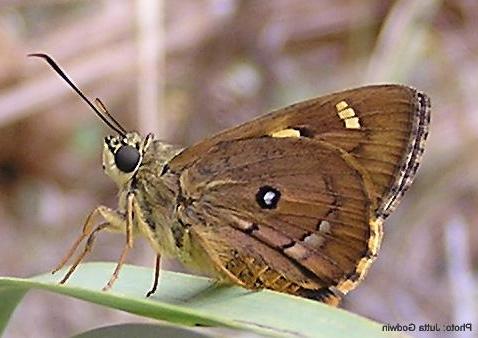
| Sandstone Ochre (previously known as Trapezites andersoni) TRAPEZITINAE, HESPERIIDAE, HESPERIOIDEA | (donherbisonevans@yahoo.com) and Stella Crossley |

(Photo: courtesy of Jutta Godwin,
Cubberla-Witton Catchments Network,
Brisbane, Queensland)

| Sandstone Ochre (previously known as Trapezites andersoni) TRAPEZITINAE, HESPERIIDAE, HESPERIOIDEA | (donherbisonevans@yahoo.com) and Stella Crossley |

(Photo: courtesy of Jutta Godwin,
Cubberla-Witton Catchments Network,
Brisbane, Queensland)
The caterpillar of this species is a translucent dirty green colour on top, with several lines along the body. The head is dark brown with pale spots, and a pale inverted 'V' mark.
The natural foodplant of the caterpillar appears to be just one subspecies of Mat-rush, namely
although in captivity it accepts other Mat-rush species. The caterpillar feeds nocturnally, and lives by day in a tubular shelter of dead leaves and silk at the base of a foodplant. The caterpillar is inclined to rest in its shelter with its head in full view blocking the shelter entrance. However, the size and pattern of markings on the head of the caterpillar closely resemble those of a seed of its natural foodplant, many of which are also found in the dead leaves a the base of the plant giving the caterpillar good camouflage. Also, the underside of the caterpillar is a pale brown which closely resembles the colour of the sandstone on which the foodplant grows. The caterpillar grows to a length of about 4 cms.

The adult butterflies are dark brown with yellow markings. They have a wingspan of about 2.5 cms.
This species occurs in a small area of the Blackdown Tableland in
Further reading :
Andrew F. Atkins,
Two new species of Trapezites Hübner (Lepidoptera: Hesperiidae: Trapezitinae) from eastern Australia,
Australian Entomologist,
Volume 24 (1997), p. 15.
Michael F. Braby,
Butterflies of Australia,
CSIRO Publishing, Melbourne 2000, vol. 1, p 111.
Peter S. Valentine & Stephen J. Johnson,
Notes on the biology and distribution of
Trapezites taori Atkins (Lepidoptera: Hesperiidae),
The Australian Entomologist,
Volume 31, Part 1 (March 2004), pp. 13-19.
 caterpillar |  butterflies |  Lepidoptera |  moths |  caterpillar |
(updated 18 November 2009, 9 November 2018)